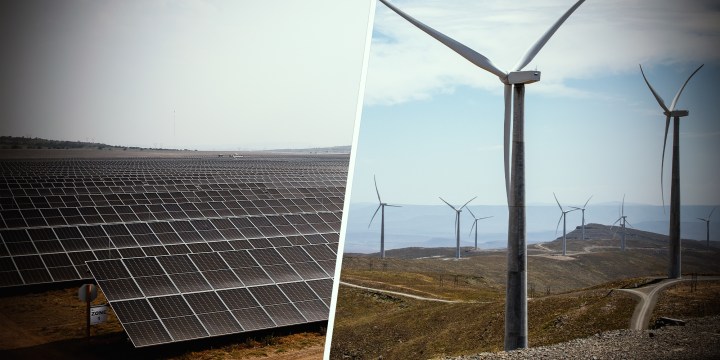POWER SHIFT
Past mistakes might hold the answer to South Africa’s successful transition to renewable energy

The fast-changing landscape for renewable energy procurement and production in the country, researchers say, calls for a capable state that learns from past mistakes and adapts to new demands.
A critical review of “the good, the bad and the ugly” of two decades of renewable energy procurement in South Africa offers some insights into what it will take to reinvigorate the country’s procurement programme.
Researchers at Wits University’s South Centre for Inequality Studies (SCIS) have looked back on six completed rounds of procurement conducted by the Renewable Energy Independent Power Producer Procurement Programme (REIPPPP).
The research, undertaken by Aalia Cassim, Julia Taylor, Professor Roderick Crompton and Professor Imraan Valodia, forms part of centre’s long-running programme looking at climate change, inequality and the impact on the macroeconomics in South Africa as well as in other low- and middle-income countries.
The challenge for developing economies, the researchers outlined in their most recently published paper, is the “complex and mammoth” task to decarbonise while battling unstable energy supply, limited resources and an incapable state.
Added to this are questions of how to reach industrialisation goals, respond to market signals more clearly and stay aligned to just energy transition objectives. Some findings from their paper were presented in an online round table discussion at the end of October.
Crompton set out how the renewable energy programme in South Africa got its start with the government’s White Paper on renewables in 2003. It took another eight years to get anything into gear, he said.
The good years and the bad years
By 2011 however, a standard renewable energy procurement model started to take shape in what Crompton described as a reverse auction model, with the lowest bidders securing 20-year off-take agreements with 20-year tariffs guaranteed or underwritten by the government. These were deals that also set out obligations to use local producers and manufacturers, and projects had to prioritise community development and upliftment.
“The period between bidding rounds one to four were the good years. The processes were internationally acclaimed; there was good market receptivity and even though the banks were nervous because everything was new, they were on board,” Crompton said. In this time 6,300MW was procured to bolster the grid and to date about 6,100MW continues to be available, he said.
“Then came the bad years when State Capture hit, including at the state-owned monopoly of Eskom. Eskom simply said, ‘We are not buying’, and renewables ground to a halt for four to five years,” he said.
After that pause, Crompton said South Africa entered its current “ugly” phase, marked by “haphazard and stop-start bidding rounds”. In bidding round five he said 2,800MW was procured but around 1,000MW of this remains unrealised as “projects under construction”. He added that bidding round six has had no traction, and he described round seven as “losing direction”.
Crompton is an adjunct professor at Wits Business School’s African Energy Leadership Centre and was previously deputy director general in the Department of Minerals and Energy. He was also a board member on the National Energy Regulator of South Africa and still serves as a non-executive board member at Eskom.
He said in looking ahead there are questions of whether the bidding process is still irrelevant. Some smaller independent power producers are already building projects like microgrids, bypassing the REIPPPP. Crompton warned that stop-start bidding processes and long limbos between bid windows has discouraged investors and manufacturers, who can’t operate with extended delays and uncertainty.
He also flagged his concern about the continued reliance on government funding in a maturing market. For him, there is high risk when the government can pull the plug on projects or withdraw subsidies on a whim.
‘Investment-centred’ approach
Taylor, who is a researcher on SCIS’s climate and inequality programme, said in the webinar that their research argues for an “investment-centred” financing and funding approach.
She said an investment-centred model could have elements of de-risking to attract private capital but would have to have set conditions and be focused on the government having an active co-ordinating and market-shaping role.
“While the South African state has attempted to encourage local manufacturing through local content requirements within the REIPPPP, this was not sufficient to boost local manufacturing and green industrialisation. Therefore, a greater commitment to an investment-centred approach is preferable with a focus on delivering timely outcomes … and flexible arrangements that cater to global flux,” their paper outlined.
Taylor added: “The state’s role is required for decarbonisation because decarbonisation is not always going to be the most cost-effective option, so a model must support multi-level (from national to provincial and municipal) and multi-sectoral alignment.”
Additional policy tools the authors recommend include investment in research and development, tax incentives, low-interest rate loans and export credits that support local manufacturing.
Taylor said in the future the REIPPPP would have to consider rising electricity prices and ways to arrest the widening energy divide in society. The divide sees wealthier households increasingly opting to privately fund their renewable energy needs and go off grid.
“This defection decreases revenue for Eskom and municipalities, and leaves us with more questions of how we manage electricity pricing in the country. Energy poverty is growing; it means that even when people have access to the grid, they are increasingly not able to afford to pay for electricity.
“A just energy transition, therefore, has to be focused not just on preserving jobs as we shift from fossil fuel industries but must also meet broader development objectives, so we don’t keep having uneven outcomes,” Taylor said.
Fast-shifting landscape
Valodia, who is director of SCIS, said the fast-shifting renewable energy landscape constantly throws up new issues that need addressing. Among these, he said, are the fate of stranded assets – the fossil fuel-related resources and infrastructure, such as coal stock, pipelines or power plants, that can no longer be used in the shift to decarbonise.
“The question is who will bear the costs associated with these stranded assets and what will their costs be to society. Another issue is that while we know that scaling up renewable energy will require both the public and private sectors, the questions are what will the relationships look like and what will financing, regulations and subsidies look like. There is also the question of how off-take agreements that have long payback periods will be managed and how pricing will be adjusted as things like costs come down.”
Valodia said modelling scenarios for the future of renewable energies in this dynamic landscape is tricky. But a backwards glance using history spotlights lessons to be learnt and old mistakes that can be sidestepped. DM



















 Become an Insider
Become an Insider
Comments - Please login in order to comment.